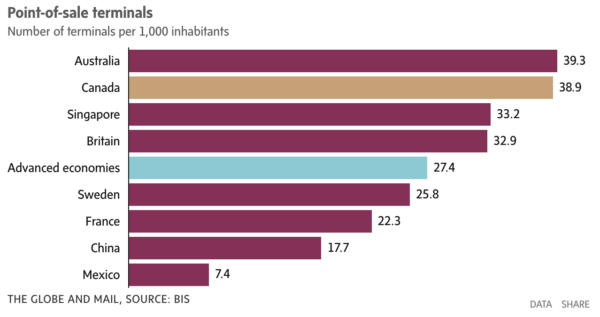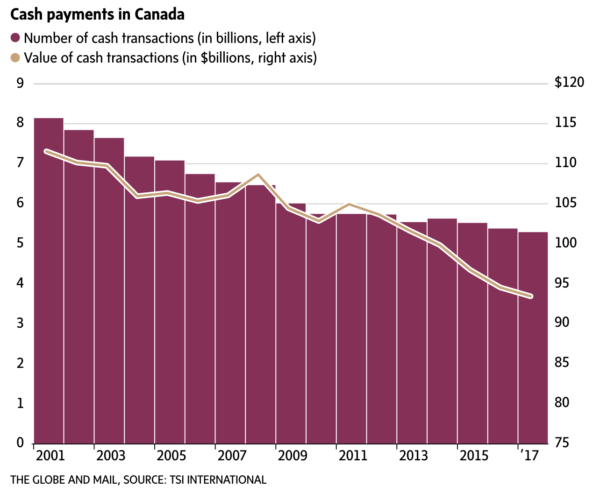Going cashless: How far will Canadians go in parting with their bills and coins?
This is the first of a multi-part series that looks at Canada’s movement toward a cashless society.
Soon after recreational cannabis consumption was legalized in Canada in October, the Office of the Privacy Commissioner offered some advice to consumers: If you are wary of leaving a track record of your purchases, try buying marijuana with cash rather than a credit card.
If this advice seems curiously out of sync with today’s trends, it is: Canada is becoming an increasingly cashless society as credit cards, debit cards, contactless payments, electronic transfers and phone apps give consumers any number of alternatives to counting bills and hauling change.
A survey published Monday by Angus Reid Institute in partnership with The Globe and Mail found that 63 per cent of 1,500 respondents agreed either strongly or moderately that they hardly ever carry cash. The number was particularly high among the younger set: 70 per cent of respondents between the ages of 26 and 37 were cash averse. But, remarkably, 57 per cent of Canadians over the age of 55 also said they hardly ever carry cash.
Some bank branches operated by Canadian Imperial Bank of Commerce no longer handle cash at their counters, where teams provide advice instead. Anyone who needs cash can turn to nearby ATMs. And a number of retailers, including Mad Radish, a quick-serve restaurant chain with four locations in Ottawa and Toronto, are now cashless.
“It goes back to the one thing that we all hold, and that’s a mobile phone,” said Jeff Guthrie, chief sales and marketing officer at Moneris Solutions Corp., which processes debit and credit card transactions.
Yet, as the Privacy Commissioner’s advice makes clear, cash still serves a purpose for anyone who wants anonymity. And it remains a necessity for many older Canadians, rural communities and cost-conscious retailers. The importance of cash may be dwindling, but will it ever disappear?
Sweden is closest to the cashless ideal. There, the ratio of banknotes in circulation relative to the country’s gross domestic product – a common metric used to describe a country’s reliance on cash – has been falling steadily for decades, from about 5 per cent in 1990 to a ratio that’s now approaching 1 per cent today. That compares with a cash-to-GDP ratio of 19 per cent in Japan, 8 per cent in the United States (where a lot of cash is held overseas) and 4 per cent in Canada.

Put another way, cash in circulation in Sweden fell 44 per cent between 2006 and 2016. Today, cash might not get you a parking spot, a bus ride or a ticket to a museum. An Ikea store north of Stockholm discovered that less than 1 per cent of purchases were made with cash. A recent study found that young consumers between the ages of 18 to 24 used debit or a smartphone for 95 per cent of their purchases.
Sweden has been at the forefront of the cashless trend because it is a relatively small country with a concentrated financial system, a modern payments infrastructure and a consumer culture that has already embraced credit cards.
While Canada’s cash-to-GDP ratio lags Sweden’s and has been relatively stable for three decades, Canada is near the top of the list of cashless countries based on consumer access to cash alternatives.
The Switzerland-based Bank for International Settlements, essentially the central bank for central banks, noted in a recent quarterly review that Canada registered the biggest increase in the density of point-of-sale terminals (where consumers can pay with cards) between 2007 and 2016. For every 1,000 people, we have 38.9 terminals, which is slightly less than Australia, but more than Britain, Singapore, Switzerland – and even Sweden.

Moneris expects that Canadian cash transactions will account for just 10 per cent of money spent by 2030, marking a stunning 70-per-cent decline from 2014.
We appear to be well on our way with this trend, according to Payments Canada, the organization responsible for the country’s clearing and settlement infrastructure. Its most recent report of payment methods and trends, released in December, found that cash represents just 12 per cent of the value of point-of-sale transactions – compared with 28 per cent for debit cards and 58 per cent for credit cards.
In 2016, the value of electronic transfers surpassed the value of cheques for the first time. And the number of contactless payments using a debit card, which allow consumers to “tap” their cards instead of entering a PIN, account for nearly 50 per cent of debit transactions.
“Generally, retailers are going to go in the direction that consumers are going,” said Michael LeBlanc, senior retail adviser at the Retail Council of Canada. “So the march toward payments-without-cash has been fairly pronounced over the last number of years. That’s even more pronounced now with tap, or contactless payments.”

The Toronto District School Board began accepting online payments in 2018 for school activities, freeing parents from the hassle of finding $5.50 in cash to pay for their child’s pizza days. The board turned to KEV Group Inc. for payment processing software.
“When we started selling cashless solutions to school boards in 2007 there were a few early adopters, but for the most part they didn’t think it was something that school administrators or parents would use,” Bram Belzberg, chief executive of KEV Group, wrote in an e-mail.
Now, according to Mr. Belzberg, it’s become something that every school wants. The way he sees it, the advantages are clear: Parents are rewarded with convenience, the school gets an easier way to track money and teachers are freed from collecting loonies and quarters.
Consumers aren’t the only ones benefiting from the shift. Some businesses find that handling less cash speeds up their operations and makes them less prone to robberies, while apps let retailers track consumer preferences. Declining cash helps authorities squeeze tax evaders and money launderers.
“If cryptocurrencies such as bitcoin were ever to become widely used, the demand for cash could fall further,” researchers at The Federal Reserve Bank of Chicago wrote in a 2018 report.
For all the apparent advantages of becoming a cashless society, though, cash is very persistent in some ways. In Canada, the value of outstanding $100 bills has risen to $47.1-billion, up from $15.7-billion in 2000. Some observers believe the increase suggests cash remains popular for the purposes of tax evasion and organized crime.
According to the Federal Reserve Bank of San Francisco (FRBSF), the cash in circulation within 42 countries increased by an average of 238 per cent from 2006 to 2016. Canada’s cash in circulation increased 59 per cent over this period despite the rising popularity of non-cash alternatives; Sweden’s shrinking amount of outstanding cash was a notable exception.
Why do some people still like cash? In a blog post, the FRBSF said that, apart from being convenient for some consumers, cash also satisfies a need for physical savings during nerve-racking times: “It can be convenient and reassuring to have immediate access to money, especially in case of an emergency or in situations of political or economic turmoil,” the FRBSF said.
The financial crisis is widely credited with driving cash levels higher in many countries, the FRBSF added, while low interest rates have reduced the pain of missing out on interest payments that hoarders of cash could be getting from the bank.
Cash is also preferred by some small businesses, such as independent coffee shops, where the cost of credit card transactions eats into slim profit margins. Older Canadians, who might not have access to intricate mobile phones or feel comfortable with apps and contactless terminals, are also more likely to prefer cash.
And of course, the privacy of cash offers another argument in its favour, especially if legalized marijuana remains largely confined to Canada.
“Cannabis is illegal in most jurisdictions outside of Canada and, as a result, the personal information of cannabis users is very sensitive. That is the context in which we advised purchasers who are concerned about using their credit card to consider using cash if that option is available,” a spokesperson for the Office of the Privacy Commissioner of Canada wrote in an e-mail.
Cash may be going. But it’s by no means gone.

